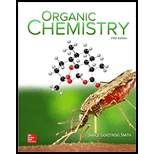
Concept explainers
(a)
Interpretation: The chair form of trans-and cis-decalin for the cyclohexane rings are to be drawn.
Concept introduction: The different spatial arrangements of atoms that results from the rotation about single bonds are called conformational isomers. The chair conformation of cyclohexane consists of six axial and six equatorial bonds.
The six axial bonds present one on each carbon atom, are parallel and alternate to each other and are in up-down position.
The six equatorial bonds present one on each carbon atom, are present in three sets of two parallel ring bonds. They are in alternate position between the sides around the ring.
(b)
Interpretation: An explanation corresponding to the fact that the trans isomer is more stable is to be stated.
Concept introduction: The different spatial arrangements of atoms that results from the rotation about single bonds are called conformational isomers. When two substituents in a conformation are in up or down direction then it is known as cis conformation. But if one substituent is in upward direction and the other is facing down direction, then the conformation is known as trans.
Want to see the full answer?
Check out a sample textbook solution
Chapter 4 Solutions
ORGANIC CHEMISTRY-MOLYMOD PACKAGE
- Compounds B and C are hydrocarbons with the structural formulae as shown below. CH, „CH, в (a) Name compounds B and C according to the IUPAC nomenclature. (b) Both B and C can undergo oxidation reaction with the same oxidizing agent. Write chemical equations involved and explain the differences between these two reactions. (c) Name one reaction that converts B to methylcyclohexane.arrow_forwardWrite the bond line formula of the following compounds: (a) 4-methyl-2-hexene, two geometrical (stereoisomers) isomers (b) 3-fluoro-2-methylheptanol (3-fluoro-2-methylheptan-1-ol) (c) 4-methyl-hex-1-yn-3-olarrow_forwardThe melting points and boiling points of two isomeric alkanes are as follows: CH3(CH2)6CH3, mp = -57 °C and bp = 126 °C; (CH3)3CC(CH3)3, mp = 102 °C and bp = 106 °C. (a) Explain why one isomer has a lower melting point but higher boiling point. (b) Explain why there is a small difference in the boiling points of the two compounds, but a huge difference in their melting points.arrow_forward
- 1. (a) Draw the structures of the eight isomeric pentyl alcohols, C3H11OH. (b) Name each by the IUPAC system and by the carbinol system. (c) Label each as primary, secondary, or tertiary, (d) Which one is isopentyl alcohol? tert-Pentyl alcohol? (e) Give the structure of a primary, a secondary, and a tertiary alcohol of the formula C,H13OH.arrow_forwardTrue or false: (a) The C¬C bonds in benzene are all the samelength and correspond to typical single C¬C bond lengths.(b) The C¬C bond in acetylene, HCCH, is longer than theaverage C¬C bond length in benzene.arrow_forwardCyclopropane (C3H6, a three-membered ring) is more reactive than most other cycloalkanes.(a) Draw a Lewis structure for cyclopropane.(b) Compare the bond angles of the carbon atoms in cyclopropane with those in an acyclic (noncyclic) alkane.(c) Suggest why cyclopropane is so reactive.arrow_forward
- 2,3-Dibromoprop-1-ene (C3H4Br2) has four H atoms. Suppose that any of these H atoms can be replaced by a Cl atom to yield a molecule with the formula C3H3Br,Cl. (a) Identify two H atoms where this substitution would yield constitutional isomers of C3H3Br,CI; (b) enantiomers of C3H3Br,Cl; (c) diastereomers of C3H3Br,Cl. H нн H Br Br 2,3-Dibromoprop-1-enearrow_forwardAre the C¬C bonds cyclopropane weaker than those in cyclohexane?arrow_forward10) 11)arrow_forward
- There are 17 possible alkene isomers with the formula C6H12. Draw structures of the five isomers in which the longest chain has six carbon atoms, and give the name of each. Are any of these isomers chiral? (There are also eight isomers in which the longest chain has five carbon atoms, and four isomers in which the longest chain has four carbon atoms. How many can you find?)arrow_forward(b) NABH, CH3 COCH,CH3 CH3CH2OH (c)arrow_forwardWrite an equation to show the proton transfer between each alkene or cycloalkene and HCl. Where two carbocations are possible, show each. (a) CH,CH,CH=CHCH, (b) 2-Pentene Cyclohexenearrow_forward
 Chemistry & Chemical ReactivityChemistryISBN:9781337399074Author:John C. Kotz, Paul M. Treichel, John Townsend, David TreichelPublisher:Cengage Learning
Chemistry & Chemical ReactivityChemistryISBN:9781337399074Author:John C. Kotz, Paul M. Treichel, John Townsend, David TreichelPublisher:Cengage Learning Chemistry & Chemical ReactivityChemistryISBN:9781133949640Author:John C. Kotz, Paul M. Treichel, John Townsend, David TreichelPublisher:Cengage Learning
Chemistry & Chemical ReactivityChemistryISBN:9781133949640Author:John C. Kotz, Paul M. Treichel, John Townsend, David TreichelPublisher:Cengage Learning Introduction to General, Organic and BiochemistryChemistryISBN:9781285869759Author:Frederick A. Bettelheim, William H. Brown, Mary K. Campbell, Shawn O. Farrell, Omar TorresPublisher:Cengage Learning
Introduction to General, Organic and BiochemistryChemistryISBN:9781285869759Author:Frederick A. Bettelheim, William H. Brown, Mary K. Campbell, Shawn O. Farrell, Omar TorresPublisher:Cengage Learning Chemistry: The Molecular ScienceChemistryISBN:9781285199047Author:John W. Moore, Conrad L. StanitskiPublisher:Cengage Learning
Chemistry: The Molecular ScienceChemistryISBN:9781285199047Author:John W. Moore, Conrad L. StanitskiPublisher:Cengage Learning



